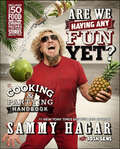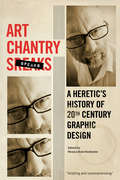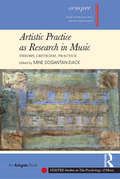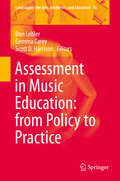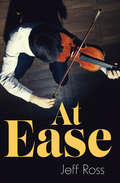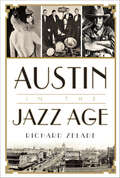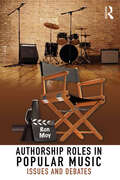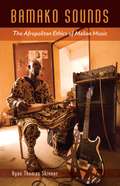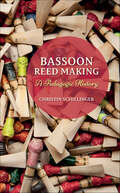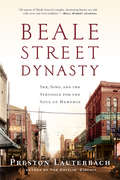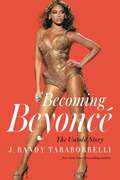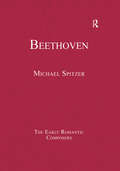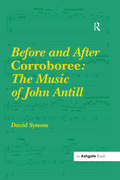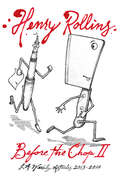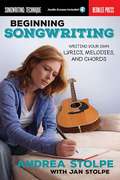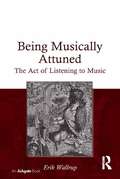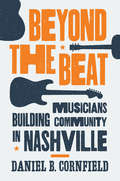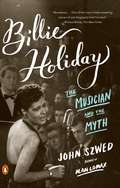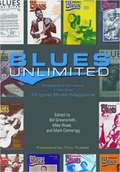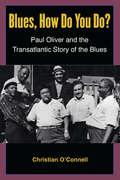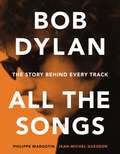- Table View
- List View
Are We Having Any Fun Yet?: The Cooking & Partying Handbook
by Sammy Hagar Josh SensIndulge yourself in the superstar rocker and #1 New York Times bestselling author’s raucous and delicious lifestyle with this bold cookbook and entertaining guide, complete with stories from a lifetime of food, signature recipes and drinks, and featuring lavish full-color photos.For over twenty years, Sammy Hagar has redefined the relationship between good food and good music through his iconic Cabo Wabo tequila brand, his popular chain of Cabo Wabo Cantina restaurants, and his newly launched rum—Sammy’s Beach Bar Rum. Now with Are We Having Any Fun Yet? any Sammy fan can eat, drink, and party like the Red Rocker himself, as Sammy shares his love of food, drinks, and rock-and-roll.Bringing you into the kitchen, behind the bar, and into the center of the party like never before, Sammy shares his deep passion for food and his secrets for rock-and-roll entertaining, including his favorite recipes from home, on the road, and his go-to vacation spots, Cabo and Maui. Coming along for the ride are a wealth of crazy tales, celebrity chefs from around the globe, and stories that reveal the inspiration behind his favorite recipes.Tracing Sammy’s culinary path through the decades, Are We Having Any Fun Yet? offers a fascinating glimpse into Sammy’s evolution as a cook and as a musician, showing how these twin passions have fueled each other, and how he brings a rock star attitude of simplicity and fun to everything he does in the kitchen. Of course, nothing goes better with a great meal than a good drink. Here are Sammy’s greatest drink recipes accompanied by true stories of the wild nights that brought them to life.With even more rock stories from the road and his table, over fifty food and drink recipes, and Sammy’s tips for entertaining like a rock star, Are We Having Any Fun Yet? gives fans everything they need to party the Cabo Wabo way.
Art Chantry Speaks
by Art Chantry Monica René RochesterThere used to be a time when designers were trained in the history of composition. Now you just buy a fuckin' piece of software and now you've become a designer."Art Chantry . . . Is he a Luddite?" asks a Rhode Island School of Design poster promoting a Chantry lecture. "Or is he a graphic design hero?"For decades this avatar of low-tech design has fought against the cheap and easy use of digital software. Chantry's homage to expired technology, and his inspired use of Xerox machines and X-Acto blade cuts of printed material, created a much-copied style during the grunge period and beyond.Chantry's designs were published in Some People Can't Surf: The Graphic Design of Art Chantry (Chronicle Books), exhibited at the Seattle Art Museum, the Rock and Roll Hall of Fame, the Museum of Modern Art, the Smithsonian, and the Louvre.More recently, Chantry has drawn upon his extraordinary collection of twentieth-century graphic art to create compelling histories of the forgotten and unknown on essays he has posted on his Facebook page. These essays might lionize the unrecognized illustrators of screws, wrenches, and pipes in equipment catalogs. Other posts might reveal how some famous artists were improperly recognized.Art Chantry Speaks is the kind of opinionated art history you've always wanted to read but were never assigned.
Artistic Practice as Research in Music: Theory, Criticism, Practice (SEMPRE Studies in The Psychology of Music)
by Mine Dogantan-DackArtistic Practice as Research in Music: Theory, Criticism, Practice brings together internationally renowned scholars and practitioners to explore the cultural, institutional, theoretical, methodological, epistemological, ethical and practical aspects and implications of the rapidly evolving area of artistic research in music. Through various theoretical positions and case studies, and by establishing robust connections between theoretical debates and concrete examples of artistic research projects, the authors discuss the conditions under which artistic practice becomes a research activity; how practice-led research is understood in conservatoire settings; issues of assessment in relation to musical performance as research; methodological possibilities open to music practitioners entering academic environments as researchers; the role of technology in processes of musical composition as research; the role and value of performerly knowledge in music-analytical enquiry; issues in relation to live performance as a research method; artistic collaboration and improvisation as research tools; interdisciplinary concerns of the artist-researcher; and the relationship between the affordances of a musical instrument and artistic research in musical performance. Readers will come away from the book with fresh insights about the theoretical, critical and practical work being done by experts in this exciting new field of enquiry.
Assessment in Music Education: From Policy To Practice (Landscapes: the Arts, Aesthetics, and Education #16)
by Scott D. Harrison Don Lebler Gemma CareyThe contributions to this volume aim to stimulate discussion about the role of assessment in the learning experiences of students in music and other creative and performing arts settings. The articles offer insights on how assessment can be employed in the learning setting to enhance outcomes for students both during their studies at higher education institutions and after graduation. An international group of leading researchers offers an exciting array of papers that focus on the practice of assessment in music, particularly in higher education settings. Contributions reflect on self-, peer- and alternative assessment practices in this environment. There is a particular emphasis on the alignment between assessment, curriculum structure and pedagogy.
At Ease (Orca Limelights)
by Jeff RossAt fifteen, Will already knows he wants to spend his life playing classical violin. When Will is invited to take part in a summer program for young musicians, he realizes it is a chance to make his dream a reality. But years of playing only for Mr. Jorgensen, his elderly neighbor and mentor, haven’t prepared Will for what will happen when he steps onto the stage. He never expected the self-doubt that takes over his thoughts, or the fear of failure that makes his hands shake and his heart race. What happens when the one thing you need to achieve your dreams is something you find utterly terrifying? This short novel is a high-interest, low-reading level book for middle-grade readers who are building reading skills, want a quick read or say they don’t like to read!
Audio Watermark: A Comprehensive Foundation Using MATLAB
by Yiqing Lin Waleed H. AbdullaThis book illustrates the commonly used and novel approaches of audio watermarking for copyrights protection. The author examines the theoretical and practical step by step guide to the topic of data hiding in audio signal such as music, speech, broadcast. The book covers new techniques developed by the authors are fully explained and MATLAB programs, for audio watermarking and audio quality assessments and also discusses methods for objectively predicting the perceptual quality of the watermarked audio signals. Explains the theoretical basics of the commonly used audio watermarking techniques Discusses the methods used to objectively and subjectively assess the quality of the audio signals Provides a comprehensive well tested MATLAB programs that can be used efficiently to watermark any audio media
Austin in the Jazz Age
by Richard ZeladeThough renowned, Austin's contemporary music scene pales in comparison with the explosion of creative talent the city spawned during the Jazz Age. Dozens of musicians who started out in the capital city attained national and international fame--but music was just one form of artistic expression that marked that time of upheaval. World War I's death and destruction bred a vehement rejection of the status quo. In its place, an enthusiastic adherence to life lived without question or consequence took root. The sentiment found fertile soil in Austin, with the University of Texas at the epicenter. Students indulged in the debauchery that typified the era, scandalizing Austin and Texas at large as they introduced a freewheeling, individualistic attitude that now defines the city. Join author Richard Zelade in a raucous investigation of the day and its most outstanding and outlandish characters.
Authorship Roles in Popular Music: Issues and Debates
by Ron MoyAuthorship Roles in Popular Music applies the critical concept of auteur theory to popular music via different aspects of production and creativity. Through critical analysis of the music itself, this book contextualizes key concepts of authorship relating to gender, race, technology, originality, uniqueness, and genius and raises important questions about the cultural constructions of authenticity, value, class, nationality, and genre. Using a range of case studies as examples, it visits areas as diverse as studio production, composition, DJing, collaboration, performance and audience. This book is an essential introduction to the critical issues and debates surrounding authorship in popular music. It is an ideal resource for students, researchers, and scholars in popular musicology and cultural studies.
Bach's Numbers
by Ruth TatlowIn eighteenth-century Germany the universal harmony of God's creation and the perfection of its proportions still held philosophical, moral and devotional significance. Reproducing proportions close to the unity (1:1) across compositions could render them beautiful, perfect and even eternal. Using the principles of her groundbreaking theory of proportional parallelism and the latest source study research, Ruth Tatlow reveals how Bach used the number of bars to create numerical perfection across his published collections, and explains why he did so. The first part of the book illustrates the wide-ranging application of belief in the unity, showing how planning a well-proportioned structure was a normal compositional procedure in Bach's time. In the second part Tatlow presents practical demonstrations of this in Bach's works, illustrating the layers of proportion that appear within a movement, a work, between two works in a collection, across a collection and between collections.
Bamako Sounds: The Afropolitan Ethics of Malian Music (A Quadrant Book)
by Ryan Thomas SkinnerBamako Sounds tells the story of an African city, its people, their values, and their music. Centered on the music and musicians of Bamako, Mali&’s booming capital city, this book reveals a community of artists whose lives and works evince a complex world shaped by urban culture, postcolonialism, musical expression, religious identity, and intellectual property.Drawing on years of ethnographic research with classically trained players of the kora (a twenty-one-string West African harp) as well as more contemporary, hip-hop influenced musicians and producers, Ryan Thomas Skinner analyzes how Bamako artists balance social imperatives with personal interests and global imaginations. Whether performed live on stage, broadcast on the radio, or shared over the Internet, music is a privileged mode of expression that suffuses Bamako&’s urban soundscape. It animates professional projects, communicates cultural values, pronounces public piety, resounds in the marketplace, and quite literally performs the nation. Music, the artists who make it, and the audiences who interpret it thus represent a crucial means of articulating and disseminating the ethics and aesthetics of a varied and vital Afropolitanism, in Bamako and beyond.
Bassoon Reed Making: A Pedagogic History
by Christin SchillingerWithheld by leading pedagogues in an effort to control competition, the art of reed making in the early 20th century has been shrouded in secrecy, producing a generation of performers without reed making fluency. While tenets of past decades remain in modern pedagogy, Christin Schillinger details the historical pedagogical trends of bassoon reed making to examine the impact different methods have had on the practice of reed making and performance today. Schillinger traces the pedagogy of reed making from the earliest known publication addressing bassoon pedagogy in 1687 through the publication of Julius Weissenborn's Praktische Fagott-Schule and concludes with an in-depth look at contemporary methodologies developed by Louis Skinner, Don Christlieb, Norman Herzberg, and Lewis Hugh Cooper. Aimed at practitioners and pedagogues of the bassoon, this book provides a deeper understanding of the history and technique surrounding reed-making craft and instruction.
Beale Street Dynasty: Sex, Song, and the Struggle for the Soul of Memphis
by Preston LauterbachThe vivid history of Beale Street--a lost world of swaggering musicians, glamorous madams, and ruthless politicians--and the battle for the soul of Memphis. Following the Civil War, Beale Street in Memphis, Tennessee, thrived as a cauldron of sex and song, violence and passion. But out of this turmoil emerged a center of black progress, optimism, and cultural ferment. Preston Lauterbach tells this vivid, fascinating story through the multigenerational saga of a family whose ambition, race pride, and moral complexity indelibly shaped the city that would loom so large in American life. Robert Church, who would become "the South's first black millionaire," was a mulatto slave owned by his white father. Having survived a deadly race riot in 1866, Church constructed an empire of vice in the booming river town. He made a fortune with saloons, gambling, and--shockingly--white prostitution. But he also nurtured the militant journalism of Ida B. Wells and helped revolutionize American music through the work of composer W.C. Handy, the man who claimed to have invented the blues. In the face of Jim Crow, the Church fortune helped fashion the most powerful black political organization of the early twentieth century. Robert and his son, Bob Jr., bought and sold property, founded a bank, and created a park and auditorium for their people finer than the places whites had forbidden them to attend. However, the Church family operated through a tense arrangement with the Democrat machine run by the notorious E. H. "Boss" Crump, who stole elections and controlled city hall. The battle between this black dynasty and the white political machine would define the future of Memphis. Brilliantly researched and swiftly plotted, Beale Street Dynasty offers a captivating account of one of America's iconic cities--by one of our most talented narrative historians.
Becoming Beyoncé: The Untold Story
by J. Randy TaraborrelliA Billboard Must-Read Fall 2015 Music Book The first comprehensive biography ever published about America's favorite living pop icon, Beyoncé, from New York Times bestselling biographer J. Randy Taraborrelli. <P><P>Beyoncé Knowles is a woman who began her career at the age of eight performing in pageant shows and talent contests, honing her craft through her teenage years until, at the age of 16, she had her first number one record with Destiny's Child. That hit-making trio launched Beyoncé's successful solo career, catapulting her, as of 2014, to #1 on Forbes annual list of most wealthy celebrities--the same year she made the cover of Time. <P><P>BECOMING BEYONCÉ is not only the story of struggle, sacrifice, and what it takes to make it in the cut-throat record industry, it's the story of the great rewards of such success and the devastating toll it often takes on the human spirit.
Beethoven: Adorno And Beethoven's Late Style (The\early Romantic Composers Ser.)
by Michael SpitzerOur image of Beethoven has been transformed by the research generated by a succession of scholars and theorists who blazed new trails from the 1960s onwards. This collection of articles written by leading Beethoven scholars brings together strands of this mainly Anglo-American research over the last fifty years and addresses a range of key issues. The volume places Beethoven scholarship within a historical and contemporary context and considers the future of Beethoven studies.
Before and After Corroboree: The Music Of John Antill
by David SymonsJohn Antill (1904-1986) was one of the foremost composers of Australia's post-colonial period. Although a relatively prolific and much esteemed composer in Australia, Antill's wider reputation is sustained chiefly by his famous ballet Corroboree - a work which was perceived to bring an authentic Australian musical style before both a national and international audience for the first time. Through Sir Eugene Goossens' championship, the work was heard by enthusiastic audiences in Australia, Britain, Europe and the USA, and was, for many years, the best-known work of any Australian-born and resident composer. Indeed it has remained, for both Australian and overseas audiences, an Australian musical icon. David Symons traces Antill's development as a composer from his early, pre-Corroboree works, which display a late Romantic to post-impressionist style, through an analysis of the virile, dissonant, primitivist idiom of his magnum opus, to an examination of his later output of theatrical, orchestral and vocal/choral works. The book provides comprehensive and valuable insight into Antill's musical output, at the same time focussing on more detailed analyses of his major works which have reached public performances and/or recordings. In this way the book not only presents a developmental picture of Antill's works, but also demonstrates why they have made him one of Australia's most prominent musical creators of the post-colonial period.
Before the Chop II
by Henry RollinsHow do you sell a book like this? It's like offering someone gum that has been previously chewed. Almost all of the material in Before The Chop II has been published in the LA Weekly. You can probably go online and find it at the best possible price. How dare the "writer" go slouching towards the trough with the audacity to re-cycle mere "content" and slap a price on it? It's a damn outrage is what it is! The hubris is bristling, the nest feathering obvious and repellent, the self-delusion total. Self-absorbed much? Running for Congress, perhaps?So again, how in the hell does anyone with a scintilla of integrity foist this carbon based catastrophe on citizens without "Hey, you dumb consumer bastard, feel the full weight of my sneering contempt, reserved just for you!" so blatantly implied? Sometimes, I hate my job.Well, maybe we could say that these are the pieces the way they were intended to be read? That all put together, they make a handy and potentially enjoyable resource for those who don't have time to read them as they stagger and fall into existence every week? Yes! Let's go with that. These are the versions before they were sent to finishing school to be refined and taught to keep their eyes and ears open and their mouths shut. This is the raw and "real" stuff, which also describes the artwork of a three year old.It could be put across that it's all about keeping the "artist" from falling into the depths of starvation and insanity. "I met Henry Rollins a few years ago. I was walking back to my car in the Rite Aid parking lot off of Fairfax. I saw a man urinating on my driver's side door. It was Henry. He smiled, waved with his free hand and said, 'TV party tonight!' then limped away." This is what we're trying to avoid.Sad how things sometimes end up, huh? That some buds never fully bloom? Ah, nature, while often cruel, always the straightest line to the truth. Well, even the mightiest redwood will one day fall. Okay, that's not a good example but nonetheless, on with the show. Get out your handkerchiefs, here it is, Before The Chop II!Can I stop now? The stench is making my eyes burn . . .
Beginning Songwriting: Writing Your Own Lyrics, Melodies, And Chords
by Andrea Stolpe Jan Stolpe(Berklee Guide). Learn to write songs! This book presents the basic concepts of popular songwriting, such as song construction, creativity techniques, melodic and harmonic development, how to write memorable lyrics, and other core topics. Hands-on exercises make it practical, and the accompanying recording illustrates the concepts for those who don't yet read music.
Being Musically Attuned: The Act of Listening to Music
by Erik WallrupListening according to mood is likely to be what most people do when they listen to music. We want to take part in, or even be part of, the emerging world of the musical work. Using the sources of musical history and philosophy, Erik Wallrup explores this extremely vague and elusive phenomenon, which is held to be fundamental to musical hearing. Wallrup unfolds the untold musical history of the German word for ’mood’, Stimmung, which in the 19th century was abundant in the musical aesthetics of the German-Austrian sphere. Martin Heidegger’s much-discussed philosophy of Stimmung is introduced into the field of music, allowing Wallrup to realise fully the potential of the concept. Mood in music, or, to be more precise, musical attunement, should not be seen as a peculiar kind of emotionality, but that which constitutes fundamentally the relationship between listener and music. Exploring mood, or attunement, is indispensable for a thorough understanding of the act of listening to music.
Beyond the Beat
by Daniel B. CornfieldAt a time when the bulwarks of the music industry are collapsing, what does it mean to be a successful musician and artist? How might contemporary musicians sustain their artistic communities? Based on interviews with over seventy-five popular-music professionals in Nashville, Beyond the Beat looks at artist activists--those visionaries who create inclusive artist communities in today's individualistic and entrepreneurial art world. Using Nashville as a model, Daniel Cornfield develops a theory of artist activism--the ways that artist peers strengthen and build diverse artist communities.Cornfield discusses how genre-diversifying artist activists have arisen throughout the late twentieth-century musician migration to Nashville, a city that boasts the highest concentration of music jobs in the United States. Music City is now home to diverse recording artists--including Jack White, El Movimiento, the Black Keys, and Paramore. Cornfield identifies three types of artist activists: the artist-producer who produces and distributes his or her own and others' work while mentoring early-career artists, the social entrepreneur who maintains social spaces for artist networking, and arts trade union reformers who are revamping collective bargaining and union functions. Throughout, Cornfield examines enterprising musicians both known and less recognized. He links individual and collective actions taken by artist activists to their orientations toward success, audience, and risk and to their original inspirations for embarking on music careers.Beyond the Beat offers a new model of artistic success based on innovating creative institutions to benefit the society at large.
Billie Holiday
by John SzwedPublished in celebration of Holiday's centenary, the first biography to focus on the singer's extraordinary musical talentWhen Billie Holiday stepped into Columbia's studios in November 1933, it marked the beginning of what is arguably the most remarkable and influential career in ?twentieth-century popular music. Her voice weathered countless shifts in public taste, and new reincarnations of her continue to arrive, most recently in the form of singers like Amy Winehouse and Adele.Most of the writing on Holiday has focused on the tragic details of her life--her prostitution at the age of fourteen, her heroin addiction and alcoholism, her series of abusive relationships--or tried to correct the many fabrications of her autobiography. But now, Billie Holiday stays close to the music, to her performance style, and to the self she created and put into print, on record and on stage.Drawing on a vast amount of new material that has surfaced in the last decade, critically acclaimed jazz writer John Szwed considers how her life inflected her art, her influences, her uncanny voice and rhythmic genius, a number of her signature songs, and her legacy.
Billie Holiday: The Musician and the Myth
by John Szwed* Kirkus Best Books of 2015 selection for Biography *Published in celebration of Holiday's centenary, the first biography to focus on the singer's extraordinary musical talentWhen Billie Holiday stepped into Columbia's studios in November 1933, it marked the beginning of what is arguably the most remarkable and influential career in twentieth-century popular music. Her voice weathered countless shifts in public taste, and new reincarnations of her continue to arrive, most recently in the form of singers like Amy Winehouse and Adele.Most of the writing on Holiday has focused on the tragic details of her life--her prostitution at the age of fourteen, her heroin addiction and alcoholism, her series of abusive relationships--or tried to correct the many fabrications of her autobiography. But now, Billie Holiday stays close to the music, to her performance style, and to the self she created and put into print, on record and on stage.Drawing on a vast amount of new material that has surfaced in the last decade, critically acclaimed jazz writer John Szwed considers how her life inflected her art, her influences, her uncanny voice and rhythmic genius, a number of her signature songs, and her legacy.From the Hardcover edition.
Billie Holiday: The Musician and the Myth
by John Szwed* Kirkus Best Books of 2015 selection for Biography *Published in celebration of Holiday's centenary, the first biography to focus on the singer's extraordinary musical talentWhen Billie Holiday stepped into Columbia's studios in November 1933, it marked the beginning of what is arguably the most remarkable and influential career in twentieth-century popular music. Her voice weathered countless shifts in public taste, and new reincarnations of her continue to arrive, most recently in the form of singers like Amy Winehouse and Adele.Most of the writing on Holiday has focused on the tragic details of her life--her prostitution at the age of fourteen, her heroin addiction and alcoholism, her series of abusive relationships--or tried to correct the many fabrications of her autobiography. But now, Billie Holiday stays close to the music, to her performance style, and to the self she created and put into print, on record and on stage.Drawing on a vast amount of new material that has surfaced in the last decade, critically acclaimed jazz writer John Szwed considers how her life inflected her art, her influences, her uncanny voice and rhythmic genius, a number of her signature songs, and her legacy.From the Hardcover edition.
Blues Unlimited: Essential Interviews from the Original Blues Magazine
by Bill Greensmith Mark Camarigg Tony Russell Mike RoweBritish blues fan Mike Leadbitter launched the magazine Blues Unlimited in 1963. The groundbreaking publication fueled the then-nascent, now-legendary blues revival that reclaimed seminal figures like Son House and Skip James from obscurity. Throughout its history, Blues Unlimited heightened the literacy of blues fans, documented the latest news and career histories of countless musicians, and set the standard for revealing long-form interviews. Conducted by Bill Greensmith, Mike Leadbitter, Mike Rowe, John Broven, and others, and covering a who's who of blues masters, these essential interviews from Blues Unlimited shed light on their subjects while gleaning colorful detail from the rough and tumble of blues history. Here is Freddie King playing a string of one-nighters so grueling it destroys his car; five-year-old Fontella Bass gigging at St. Louis funeral homes; and Arthur "Big Boy" Crudup rising from life in a packing crate to music stardom. Here, above all, is an eyewitness history of the blues written in neon lights and tears, an American epic of struggle and transcendence, of Saturday night triumphs and Sunday morning anonymity, of clean picking and dirty deals. Featuring interviews with: Fontella Bass, Ralph Bass, Fred Below, Juke Boy Bonner, Roy Brown, Albert Collins, James Cotton, Arthur "Big Boy" Crudup, Joe Dean, Henry Glover, L.C. Green, Dr. Hepcat, Red Holloway, Louise Johnson, Floyd Jones, Moody Jones, Freddie King, Big Maceo Merriweather, Walter Mitchell, Louis Myers, Johnny Otis, Snooky Pryor, Sparks Brothers, Jimmy Thomas, Jimmy Walker, and Baby Boy Warren.
Blues, How Do You Do?: Paul Oliver and the Transatlantic Story of the Blues
by Christian O'ConnellRecent revisionist scholarship has argued that representations by white "outsider" observers of black American music have distorted historical truths about how the blues came to be. While these scholarly arguments have generated an interesting debate concerning how the music has been framed and disseminated, they have so far only told an American story, failing to acknowledge that in the post-war era the blues had spread far beyond the borders of the United States. As Christian O'Connell shows in Blues, How Do You Do? Paul Oliver's largely neglected scholarship--and the unique transatlantic cultural context it provides--is vital to understanding the blues. O'Connell's study begins with Oliver's scholarship in his early days in London as a writer for the British jazz press and goes on to examine Oliver's encounters with visiting blues musicians, his State Department-supported field trip to the US in 1960, and the resulting photographs and oral history he produced, including his epic "blues narrative," The Story of the Blues (1969). Blues, How Do You Do? thus aims to move away from debates that have been confined within the limits of national borders--or relied on clichés of British bands popularizing American music in America--to explore how Oliver's work demonstrates that the blues became a reified ideal, constructed in opposition to the forces of modernity.
Bob Dylan All the Songs: The Story Behind Every Track (All The Songs)
by Jean-Michel Guesdon Philippe Margotin<P>This is the most comprehensive account of Bob Dylan's work yet published with the full story of every recording session, every album, and every single released during his remarkable and illustrious 53-year career. <P>Bob Dylan: All the Songs focuses on Dylan's creative process and his organic, unencumbered style of recording. It is the only book to tell the stories, many unfamiliar even to his most fervent fans, behind all the 492 songs he released. Organized chronologically by album, Margotin and Guesdon recount the details that led to the composition of Dylan's recorded songs, what went on in the recording studio, what instruments he used, and behind-the-scenes account of the great artists that Dylan worked with. <P><b>A New York Times Bestseller</b>
